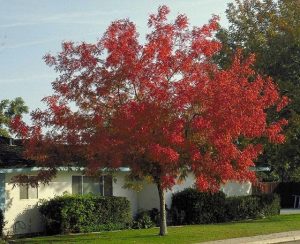By Ken Lain, the mountain gardener
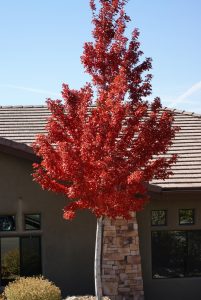
Not all trees are created equal when it comes to autumn colors, and this is their season. Autumn is also the ideal planting window for trees and tall shrubs. Increased garden success is had when plants are showing their colors. The days are cool and the soil warm so plants start with a burst of new root growth.
Don’t have time to view the entire article, see the highlights below:
- Trees stand out in any landscape like anchors.
- Trees grow slow so buy the best-looking tree you can find.
- Top mountain autumn trees are Red Maple, Amur Maple, Ornamental Pistachio, Aristocrat Pear, Prescott Red Oak, Quaking Aspen.
- Fall is the best time to plant fall colored trees
Most properties don’t have many trees. You can count on one hand the number of trees in the average landscape. Trees stand out in any landscape like anchors that bring together the foundation of a good plan. Also, don’t forget that trees increase the value of your landscape more than spas and grills.
Don’t waste money by cutting corners. Trees are where the landscape value is and no place to pinch pennies. Buy the best-looking tree you can find, bigger-is-better. Nice looking trees at the garden center turn into big, bold specimens as they mature. An ugly tree only stays ugly its entire life. Cut landscape dollars on shrubs, flowers, and hedges so your budget can afford a few specimen-sized trees to enhance your outdoor. Below are the show-offs of fabulous fall foliage.
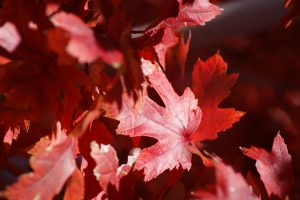
Red Celebration Maple– A very fast-growing shade tree blazed in reds and orange through Autumn. It produces a tall narrow tree with ascending branches more resistant to wind and storm damage. Widely used as a street tree, driveway lining or anyplace tight spaces demand a tree which will not spread past 20 feet with the brightest of reds in fall.
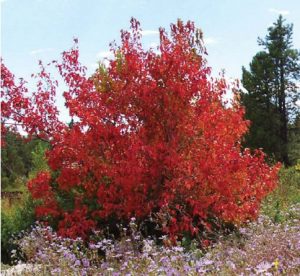
Flame Maple This little maple is famous for blazing red foliage that ignites a landscape. It’s well adapted to mountain clay soils, sun, wind, and cold winters. When established, it’s easy on the irrigation and the perfect fire-wise tree. Though sometimes mistaken for a Japanese Maple this mountain variety is the far hardier of the two trees. Whether grown as a short multi-trunk tree or a 10′ shrub, it is on my list of preferred ‘water-wise’ plants.
Ornamental Pistachio are for gardens exposed to the wind and subjected to micro-bursts or other weather anomalies. This autumn show-off thrives not only in harsh environments but neglect. The attractive umbrella shape turns a brilliant crimson; no other tree produces such a vibrant, broad range of fall reds and orange. It can serve dozens of uses: as a shade tree, street tree, accent, or front yard specimen; the ideal choice for flanking driveways in pairs. Grow this colorful low water need tree against a solid evergreen background to provide intense contrast to any landscape.
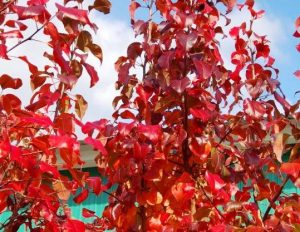
Aristocrat Pear– the last tree to turn Autumn red in December, but also celebrates the other three season of the year. This fall beauty also produces gigantic masses of white flowers in spring before the leaves appear, followed by glowing green leaves through summer that is disease and bug resistant. In winter, the clean winter outline is upright to pyramidal when young and becomes broadly oval at maturity that resists wind damage. The autumn colors are disputed to be brighter than maple and rival the purple of Raywood ash.
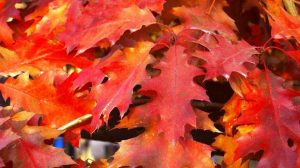
Prescott Red Oak – So deep-rooted this mountain native tree lived for hundreds of years with little to no pest issues. Its real claim to local fame is the classic red oak leaves that glow through Autumn. An outstanding pyramidal form for the perfect shade canopy in lawns, parks or a backyard patio.
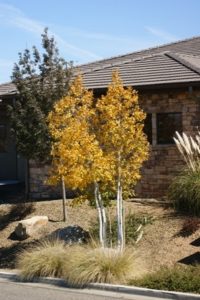
Quaking Aspen– for the past four years, the undisputed best-seller here at Watters Garden Center is Quaking Aspen, Populus tremuloides, or trembling leaf poplar. Growing in the wild at the 6000+ elevations, it does well as a cultivated specimen. Aspens have the classic pure white bark like birch but, unlike a birch, handle our clay soils even better. True to their name, the delicate leaves shiver, and quake at the slightest breeze. For a natural look with aspens, plant them in clusters, or buy a clump of aspens in the same container. They are social trees and like to hang out together in groupings — best planted before the Thanksgiving holiday.
Free Planting Guide – I just created a new planting guide that ensures your tree will grow
for years to come. Free when you visit the garden center and even includes how
to maximize growth next spring.
Until next issue, I’ll be helping gardens plant the brightest autumn-colored
trees here at Watters Garden Center.
Ken Lain can be found throughout the week at Watters Garden Center, 1815 W. Iron Springs Rd in Prescott, or contacted through WattersGardenCenter.com or FB.com/WattersGardenCenter.


